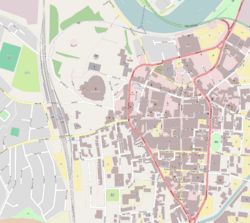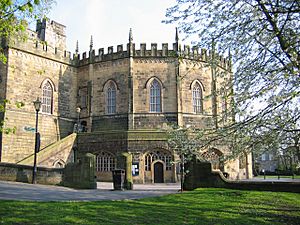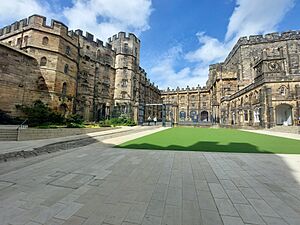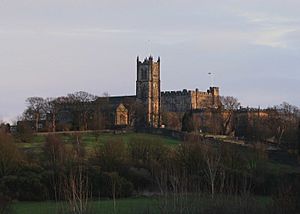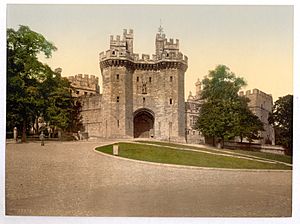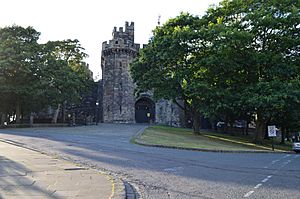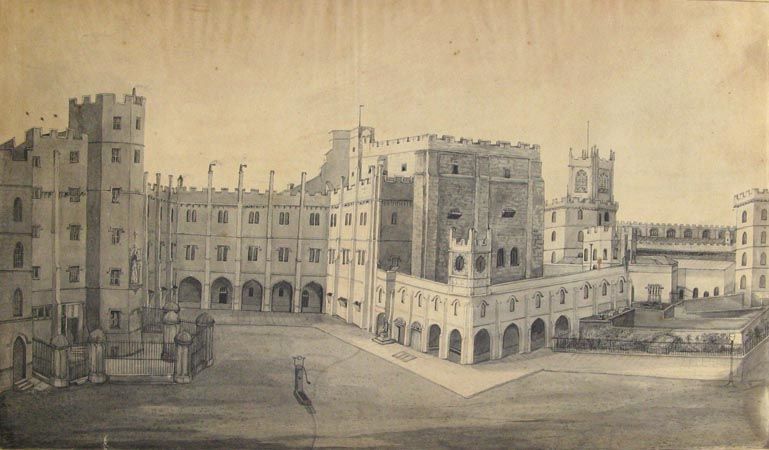Lancaster Castle facts for kids
Quick facts for kids Lancaster Castle |
|
|---|---|
| Lancaster, Lancashire, England | |

Lancaster Castle's entrance
|
|
| Coordinates | 54°02′59″N 2°48′20″W / 54.04981°N 2.80562°W grid reference SD473619 |
| Type | Castle |
Lancaster Castle is an old castle and a former prison in Lancaster, England. Nobody is completely sure when it was first built, but it might have started in the 1000s. It was built on top of an even older Roman fort overlooking the River Lune. By 1164, the castle became owned by the King of England.
In the 1300s, Scottish armies attacked England and damaged the castle. After that, it wasn't used in battles again until the English Civil War. It became a prison in 1196, and this role became very important during the English Civil War. Today, the King of England owns the castle. Part of it is still used for court hearings.
Until 2011, most of the castle was a prison called HM Prison Lancaster. After that, the castle was given back to the Duchy of Lancaster to manage. Now, the castle is open to visitors every day. It has been getting a big makeover. There's a new public area and a café built into an old wall. Lancaster University also uses a renovated building at the castle for a city campus.
Contents
Discovering Lancaster Castle's Past
Around 60 to 73 AD, the Romans built a fort in Lancaster. It was on a hill overlooking the River Lune. We don't know much about Lancaster between the end of Roman rule and the Norman Conquest in the late 1000s. The town's layout was shaped by the Roman fort.
After the Normans took over England, Lancaster became part of a larger area. In 1092, King William II secured the border with Scotland. It's believed that Lancaster Castle was built in the 1090s. It was placed on the Roman fort's site because it was a good strategic spot. The castle is the oldest building still standing in Lancaster. Its history is a bit mysterious because it was a prison for so long. This made it hard to do much archaeological digging.
Castle History and Changes
How the Castle Began

We don't have old papers saying exactly when or who started building the castle. But people think Roger de Poitou, a Norman lord, was responsible. If Roger started it, the first castle would have been made of wood. It probably used the earth walls of the Roman fort for protection. We don't know what the first castle looked like. It might have been a ringwork – a circular defended area.
Roger de Poitou left England in 1102 after a failed rebellion. The king took back the Honour of Lancaster, which included the castle. The castle changed owners several times. In 1139, a civil war called the Anarchy started. David I of Scotland occupied the area in 1141. He might have made the castle stronger then. The war ended in 1153. After this, the King of Scotland gave up the Honour of Lancaster. In 1164, the castle came under royal control again.
When King Henry II died, his son Richard the Lionheart gave the castle to his brother, Prince John. Castles were often used as prisons. The first record of Lancaster Castle being a prison was in 1196. This role became much more important after the English Civil War. Since the 1100s, the king appointed a sheriff to keep peace in Lancashire. This person usually worked from the castle.
In the late 1100s and early 1200s, many wooden castles were rebuilt with stone. Lancaster was one of them. Building with stone was very expensive and took a long time. King John spent over £630 on digging a ditch and building "the King's lodgings." This is probably what we now call Adrian's Tower. His son, King Henry III, also spent a lot of money. He spent £200 in 1243 and £250 in 1254. This was for work on the gatehouse and building a stone curtain wall.
The Castle in the 1300s and 1400s
For the next 150 years, there aren't many records of building work. The Well Tower might be from the early 1300s. If there wasn't much work, it might mean the castle wasn't seen as very important. However, Scottish armies attacked in 1322 and 1389. They reached Lancaster and damaged the castle.
When Henry, Duke of Lancaster, became King Henry IV in 1399, he quickly started building a huge gatehouse. Another attack on the town would have been embarrassing for the new king. His expensive building project helped protect against this. The new gatehouse was much stronger than the old one. Records show that over £2,500 was spent on building between 1402 and 1422. Most of this money went to the gatehouse. Since then, the castle has always belonged to the Crown.
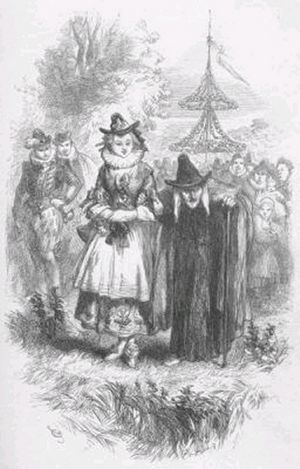
After the Scottish attack in 1389, Lancaster Castle wasn't involved in battles again until the English Civil War. In 1578, repairs were made to the keep. The castle was made stronger in 1585 because of a possible Spanish invasion. Many Roman Catholic priests were tried at Lancaster Castle during this time. The famous Pendle witches trial also happened at Lancaster Castle in 1612.
The English Civil War and Beyond
At the start of the Civil War, Lancaster had few soldiers. A small Parliamentarian army took the castle in February 1643. They built defenses around the town. The Royalists then tried to take Lancaster back. They captured the outer defenses in March. The castle itself was only under siege for two days. Parliament kept control of the town and castle until the war ended.
After the war, orders were given to pull down the castle walls. But this didn't fully happen. In August 1648, the town survived another siege. King Charles I was executed in 1649. Parliament again ordered parts of the castle to be destroyed, except for buildings needed for administration and as a prison. The monarchy was restored in 1660. King Charles II visited Lancaster and released all prisoners. After parts of the castle were destroyed, it was no longer useful for military purposes.
The Castle as a Prison
In 1554, George Marsh was held at the castle before his trial. Some Quakers, like George Fox in 1660, were also held there for their beliefs. County prisons like this were meant for holding prisoners for short times before their trials. The castle also held people who couldn't pay their debts. In the 1700s, prisons started holding people for longer. This led to overcrowding.
John Howard, a prison reformer, visited Lancaster in 1776. He saw the conditions in the prison. His work led to changes, like separating prisoners by gender and crime. Improvements were also made to cleanliness. In the late 1700s, about £30,000 was spent rebuilding Lancaster's prison. Architect Thomas Harrison led this work. He built the Gaoler's House in 1788 in a Gothic style. Separate prisons were built for men and women. The Shire Hall and Crown Court were finished by 1798.
People sentenced to death before 1800 were usually taken to Lancaster Moor for their punishment. After the castle was rebuilt, it was decided to carry out punishments closer to the castle. This spot became known as Hanging Corner. Lancaster has a reputation for sentencing many people to death. This is partly because, until 1835, it was the only main court for the whole county. This included big cities like Manchester and Liverpool. Between 1782 and 1865, many people faced severe punishment at Lancaster. These events were often watched by thousands of people.
The Capital Punishment Amendment Act 1868 stopped public punishments. After this, a few more punishments happened inside the castle walls. The last punishment at Lancaster took place in 1910. The prison closed in 1916 because there were fewer prisoners. During part of the First World War, it held German civilians and military prisoners of war.
Between 1931 and 1937, the castle was used to train police officers. Lancaster became a prison again from 1954. The last major court hearings were held at Lancaster in 1972. Because the court and prison were so close, Lancaster was used for important trials.
The castle officially opened as HM Prison Lancaster in 1955. It was a prison for men and a place for the Crown Court. In July 2010, the Ministry of Justice announced it would close the prison. They said it was old and too expensive. The prison closed in March 2011.
Lancaster Castle Today
The Crown Court still holds hearings at the castle. Since the prison closed, the castle has been opening up to visitors. While some parts like the old dungeons are not yet fully open, the castle offers guided tours every day. The Castle Courtyard opened to the public in May 2013. It now has a café and hosts regular events. The Lancashire Police Museum opened in June 2022 inside one of the former prison wings.
To remember 400 years since the Pendle witches trials, a new walking route was created. It's called the Lancashire Witches Walk. Special markers with poems are placed along the route, with the last one at the castle.
Castle Refurbishment
A big project to fix up the castle has been happening since 2011. In 2016, experts looked at old wood from the Keep and Gatehouse. They found that oak timbers in the Keep were cut in the 1380s. The wood in the Gatehouse was likely cut around 1404.
The latest part of the refurbishment finished in November 2019. It opened up the old prison kitchen yard. This created a new teaching center. A section of the old kitchen is now leased to a local coffee company, J. Atkinson & Co., for a café.
Castle Layout and Features
The keep is the oldest part of the castle. We don't know exactly when it was built, but it's probably from the 1100s. It was where the castle's owner lived. If the castle was attacked, the keep was the last place to defend. It is 20 meters (66 feet) high and has four floors. Each floor has two rooms. The outer walls are 3 meters (10 feet) thick. Building it from stone would have taken about five years and cost a lot of money. The old medieval hall was taken down in 1796. The Shire Hall, built later, is a large ten-sided room next to the keep.
In the castle's southwest corner is a round tower called Adrian's Tower. People used to think the Roman Emperor Hadrian built it. But the tower was actually built in the early 1200s, probably when King John was in charge. Even though the outside was redone in the 1700s, you can still see medieval stonework inside.
The main entrance is through a 20-meter (66-foot) high gatehouse. It was built in the early 1400s by King Henry IV. Two towers stand on either side of a passage. A portcullis (a heavy gate) protected the entrance. Battlements above the gatehouse allowed defenders to drop things on attackers. Above the gate, there's a space where a statue of a saint used to be. In the 1800s, a statue of John of Gaunt was placed there. The gatehouse has three floors. The ground floor apartment was probably used by the castle's Constable. After the English Civil War, many rooms in the gatehouse were filled with people who owed money.
During the Roman times, in the 300s, the fort was surrounded by the "Wery Wall." This wall was described as a 3-meter (10-foot) thick, very strong mass with a defensive ditch. Today, you can only see parts of it on the east side of Castle Hill. The remaining Wery Wall is made of rubble because its outer stones were used elsewhere.


